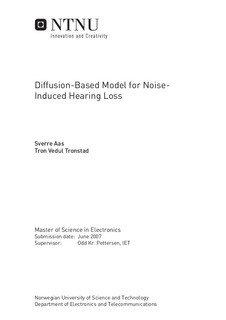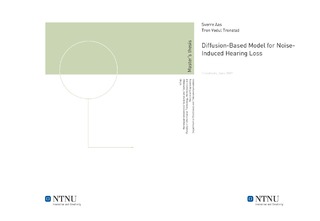| dc.contributor.advisor | Pettersen, Odd Kr. | nb_NO |
| dc.contributor.author | Aas, Sverre | nb_NO |
| dc.date.accessioned | 2014-12-19T13:43:21Z | |
| dc.date.accessioned | 2015-12-22T11:40:50Z | |
| dc.date.available | 2014-12-19T13:43:21Z | |
| dc.date.available | 2015-12-22T11:40:50Z | |
| dc.date.created | 2010-09-03 | nb_NO |
| dc.date.issued | 2007 | nb_NO |
| dc.identifier | 347498 | nb_NO |
| dc.identifier.uri | http://hdl.handle.net/11250/2369069 | |
| dc.description.abstract | Among several different damaging mechanisms, oxidative stress is found to play an important role in noise-induced hearing loss (NIHL). This is supported by both findings of oxidative damage after noise exposure, and the fact that upregulation of antioxidant defenses seem to reduce the ears susceptibility to noise. Oxidative stress mechanisms could help explain several of the characteristics of NIHL, and we therefore believe that it would be advantageous to estimate noise-induced hearing impairment on the basis of these, rather than the prevailing energy based methods. In this thesis we have tried to model progress of NIHL using diffusion principles, under the assumption that accumulation of reactive oxygen species (ROS) is the cause of hearing impairment. Production, and the subsequent accumulation, of ROS in a group of outer hair cells (OHCs) is assessed by different implementations of sound pressure as in-parameter, and the ROS concentration is used in estimation of noise-induced threshold shift. The amount of stress experienced by the ear is implemented as a summation of ROS concentration with different exponents of power. Measured asymptotic threshold shift (ATS) values are used as a calibrator for the development of threshold shifts. Additionally the results are evaluated in comparison to the standards developed by the International Organization for Standardization (ISO) and the American Occupational Safety and Health Administration (OSHA). Results indicate that ROS production is not directly proportional to the sound pressure, rather anaccelerated formation and accumulation for increasing sound pressure levels (SPLs). Indications are also that the correlation between concentration of ROS and either temporary threshold shift (TTS) and/or permanent threshold shift (PTS) is more complex than our assumption. Because our model is based on diffusion principles we get the same tendency of noise-induced hearing loss development as experimentally measured TTS development. It also takes into account the potentially damaging mechanisms which occur during recovery after exposure, and has the ability to use TTS data for calibration. We therefore suggest that modeling of ROS accumulation in the hair cells could be used advantageously to estimate noise-induced hearing loss. | nb_NO |
| dc.language | eng | nb_NO |
| dc.publisher | Institutt for elektronikk og telekommunikasjon | nb_NO |
| dc.subject | ntnudaim | no_NO |
| dc.title | Diffusion-Based Model for Noise-Induced Hearing Loss | nb_NO |
| dc.type | Master thesis | nb_NO |
| dc.source.pagenumber | 96 | nb_NO |
| dc.contributor.department | Norges teknisk-naturvitenskapelige universitet, Fakultet for informasjonsteknologi, matematikk og elektroteknikk, Institutt for elektronikk og telekommunikasjon | nb_NO |

